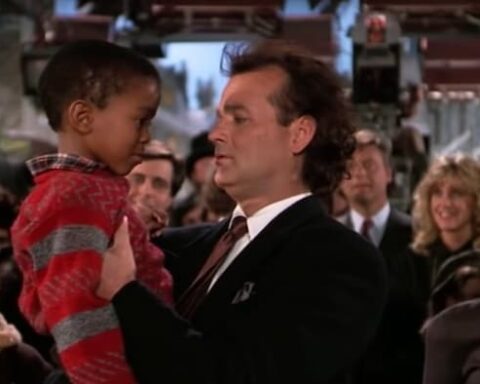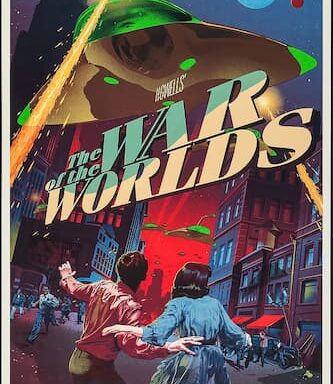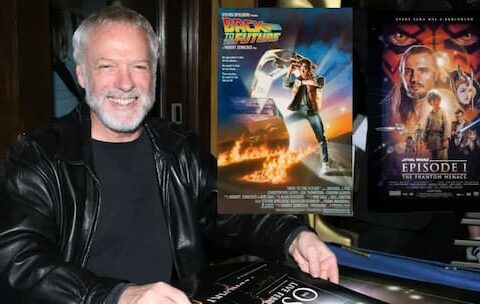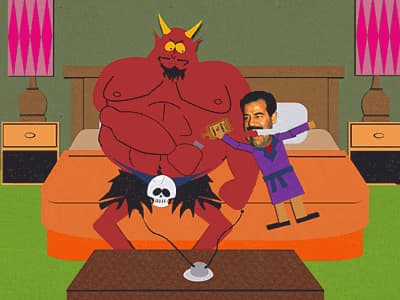‘Rewatch’ seems like an inadequate word; I’ve probably watched this movie at least fifty times since I was a kid.
Nevertheless, as it was recently the fortieth year since the release of the original George Lucas game-changing, era-defining space-opera, I decided to go for my 51st (approx) viewing of A New Hope.
Having last watched it probably some time in 2015, was there really anything new or revelatory that was going to strike me as I went through the familiar motions again of a film that I’ve known word-for-word for virtually all my life?
There was one thing that significantly altered A New Hope for me this time – and this was a little something called Rogue One.
The difference that Rogue One makes to the experience of A New Hope is substantial. It really does reinvigorate A New Hope in a big way. I now can’t watch the Death Star scenes without thinking of Galen Erso or the general events of Rogue One. In fact, Rogue One as a prologue to A New Hope is pretty fantastic.
This works on both the broad level (the Death Star, Tarkin, etc) and smaller levels.
For example, seeing Leia/Carrie for the first time early in A New Hope hit me a touch more emotionally than I had expected. I’ve seen these scenes countless times; but this was the first time I’d watched this since Carrie’s passing – and the appearance of the young, fresh-faced Princess Leia struck me in a way that it hasn’t done since I was a kid seeing it for the first time.
With that first iconic sight of her the white robe, the brief swell of John Williams’s ‘Princess Leia Theme’, I realised – not for the first time – that your reaction to Star Wars films is constantly changing, constantly different, depending on where you are in your life.
Also, with the fairly magical Rogue One ending now in our minds (literally, the end appearance of CGI Leia in the same iconic white robe), these early/initial Leia moments resonate even more strongly now and feel mythic in a way that they didn’t before.
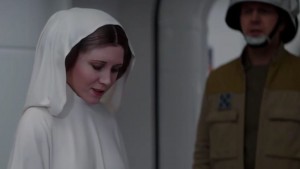
In short, Rogue One does wonders for A New Hope – a film that is otherwise so familiar to us that we almost take it for granted or become jaded about it.
In truth, 2005’s Revenge of the Sith also reinvigorated A New Hope a lot for me – probably not as directly or obviously as Rogue One does, but still meaningfully (in particular, the breathtaking final shot of ROTS – the Tatooine twin sunset – really sets up ANH beautifully). While people have their quibbles with ROTS and with the prequels in general, I’ve generally found transitioning from ROTS to ANH fairly good.
Now with Rogue One added inbetween them, it works even better.
Though, admittedly, there are little details that don’t work so well. While the overall transition/chronology does work – mostly in tone and feeling – some of the micro-elements fall a little short. In terms of the Rogue One to A New Hope transition, the biggest problem is probably Darth Vader.
This is because he appears to nimble and powerful in that truly bad-ass scene at the end of Rogue One – and then seems to feeble and slow in his duel with Obi-Wan Kenobi in A New Hope. I wouldn’t trade that Vader bad-assery scene in Rogue One for all the tea in China – but it does create a slight disparity when you go into A New Hope.
In terms of the ROTS to Rogue One to ANH transition, the biggest problem is the chronology of the Death Star. Given that ROTS ends with Palpatine, Vader and Tarkin looking out at the Death Star being constructed in space (a couple of decades before the events of Rogue One), it seems incongruous that it took two decades for construction to be completed. That aspect niggles a little and doesn’t work so well. In fact, the plans for the Death Star were earlier than even ROTS and originated with the Geonosians in Attack of the Clones.
Nitpicks like this aren’t enough to hurt the general flow or the transition between films; but they do draw attention.
Something I’ve also noted a bunch of times now in rewatching A New Hope is that it is, at times, a pretty goofy movie.
Some of the dialogue and delivery is also pretty off in places: and this has always made me wonder why people were so hard on the dialogue or delivery failings in The Phantom Menace or Attack of the Clones.
You can find fault in some places with Natalie Portman’s lines or Jake Lloyd’s or Hayden Christensen’s deliveries, but I would point you to, for example, the really badly delivered dialogue between Leia and Han on the Falcon (specifically the exchange about the money) and argue that some of the perceiving failings of the prequel dialogue/delivery are the same failings in A New Hope.
For any misjudged Jake Lloyd “yippee!”, there’s also the equally silly Han Solo “yeeehooo!” when the Falcon intervenes against Vader’s Tie-Interceptor at the end of A New Hope.
I’m not knocking A New Hope, by any means – I love it. Just pointing out that it too has weak points and flaws.
All of that being said, I’m not sure anyone on the planet dislikes A New Hope or doesn’t have some soft spot for it.
I realise whenever I watch it now that I’m really not focused on or interested in any of the action scenes at all (the action sequences in ANH are pretty unengaging compared to what comes in Empire Strikes Back and Return of the Jedi), but on the character moments and interactions, which remain so iconic and resonant in saga terms.
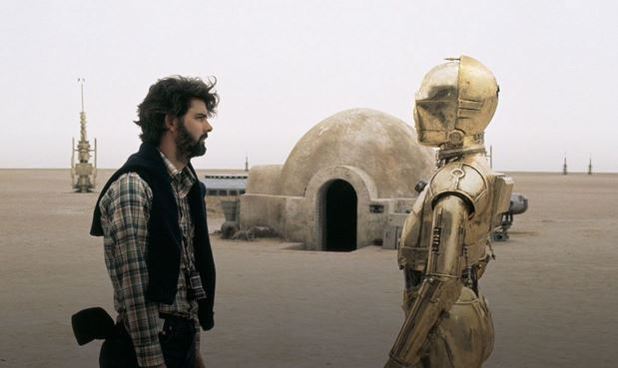
Such as the first scenes between Luke and the elderly Obi-Wan Kenobi, the aforementioned first appearances of Princess Leia, and some of the early Threepio/Artoo scenes.
It has always occurred to me that the performances of Harrison Ford, Carrie Fisher and Mark Hamill in A New Hope aren’t great. They’re much better in Empire and Jedi; but here, they’re very awkward and soap-opera-ish, even as loveable as the three of them always are.
If the acting level had stayed like this for Empire and Jedi, I’m not sure the Star Wars Trilogy would’ve been what it was.
Which, again, has always made me dubious about common complaints concerning acting or delivery in the prequels. To my mind, there’s nothing – acting-wise – in The Phantom Menace that is any worse than the central performances in A New Hope (in fact, a lot of it is actually better).
By Empire, of course, all of the performances are absolutely stellar. Even here in ANH, the chunkiness of the three main performances is counterbalanced by the perfection of Alec Guinness’s performance. Guinness and Peter Cushing (Tarkin) both bring a gravitas to the film that was very much needed – something that Lucas entirely understood. I never tire of watching Alec Guinness’s scenes; but also, the last few times I’ve watched ANH, I’ve really been able to see Ewan Magreggor’s Kenobi (particularly from ROTS) in Alec Guinness (or vice-versa), which is a testament to Magreggor’s work and in particular to the way he was made to look and feel in ROTS.
A lot of the smaller details or world-building elements also give me the feels every time, being, as I am, so steeped in Star Wars lore. Every time I see the Jawas or their sandcrawler, or the Tusken Raiders, for example, or just the sight of the Lars family homestead, it feels a touch like a religious pilgrimage.
It struck me again how much imagination is sprinkled all across even A New Hope in 1977 (letalone the later films) to create living, breathing worlds and backdrops – this is something we have to largely credit to George Lucas and it’s something I feel was missing from The Force Awakens.

You can see and taste that imagination here in ANH, even though it’s the smallest-scaled Star Wars film.
For me, I realise my favorite parts of A New Hope are all in the first half or even the first third of the film. The finale has never made a big impression on me (having already seen Empire as a child in the 80s before I saw A New Hope for the first time); I generally feel the strongest part of the film is its first third, particularly all the stuff set on Tatooine, carried by the droids, introducing Luke and eventually Obi-Wan.
Some of this stuff feels quite slow (by later SW standards); but actually their slowness works very well, allowing us to really get a feel for the environments and get a feel for the characters. This slowness (comparatively) of pace actually works all the better when you transition from Revenge of the Sith, which is so large-scale, action-packed and apocalyptic, and you come to ANH and everything is low-key, downbeat and comparatively dull.
It was always stated by Lucas too that the disparity between the prequel trilogy and ANH – in terms of scale and color and sleekness, as contrasted to the dusty, beat-up look of ANH – was an intentional thing, built in to the way he envisioned these films. In the prequels, we’re seeing the end stages of an Augustan Age in which the galactic civilisation is kind of peaking, and we’re also spending a lot of time at the centre of the galaxy, so everything is big and busy and grand.
In ANH, the Republic is gone and the whole tone of the galaxy has changed dramatically in the years between ROTS and ANH; so the difference makes perfect sense, as well as working really well in terms of sequencing.

As a result, now when we see Luke being bored on the moisture farm or staring longingly at the twin sunset, it’s no longer just him pining for adventure and escape – but it’s us as an audience (or me anyway) thinking of how much more colorful, diverse and interesting the galaxy used to be and of how much has gone on and on such a scale.
And yet now, here we are, downbeat and listless on a moisture farm.
This even plays out with Artoo and Threepio somehwat: unlike the first time we saw this film, we now have a whole differnt context for their history. We know both of them have seen vast adventure, been at the heart of galactic events and front-seat witnesses to the fall of the Republic and rise of the Empire. And yet here they are, wandering the desert, being maltreated by Jawas or being bought to live on a moisture farm. It almost feels like a fall from grace.
In the shadow of the prequel trilogy, much of ANH now feels like a downcast affair – but in a good way, that works nicely with the sequence of films.
At least Threepio has no memory of all that past, which is perhaps some mercy. But that brings me to a recurring question about Artoo Deetoo. His memory wasn’t wiped at the end of ROTS.
So, as far as we know, Artoo is carrying all of the knowledge and memory of his own history, as well as Threepio’s history, throughout all of this. Obi-Wan Kenobi isn’t some mysterious figure to him – he knows him well. He knows who Luke is. He knows who Leia is (and presumably knows she’s Luke’s sister). It adds a strange undercurrent to Artoo throughout this trilogy now, but particularly in ANH.
In fact, he even knows the Lars homestead and moisture farm – as he was here in AOTC.
You often have to wonder whether all of Star Wars is in fact Artoo Deeto’s story.
Such an idea has been hinted at by Lucas over the years; and there are a legion of Artoo fans who also subscribe to something like this notion. This brilliant, crucial droid who has to carry the burden of all the knowledge and all the answers with him throughout decades. It also perhaps creates some problems – such as whether Artoo should’ve revealed certain things to certain characters as things went along.
For that matter, Obi-Wan Kenobi doesn’t seem to recognise Artoo either. Is he playing a game here? Or does he genuinely not recognise the astromech?
And of course one of the problems with the final act is, as mentioned earlier, the slug-slow lightsaber duel between Kenobi and Vader. It’s difficult to watch, especially now that we all have the high-speed Kenobi/Anakin duel of ROTS in our minds.
That being said, the one moment that really does still permanently resonate is the exact moment of Kenobi’s self-sacrifice – it’s that knowing, smiling, serene look on Alec Guinness’s face as he deliberately lets Luke see him cut down. This brief moment really captures that sense of religious certainty and knowing surrender (to The Force); but it is also so much more powerful now (after we’ve seen ROTS and the prequels) than it even was back in the day.
Seeing all this also reminds me of how much I would love to see an intervening Obi-Wan Kenobi (Ewan Magreggor) movie set between ROTS and ANH – and not just in comic book form. There’s such a great film to be had from that.

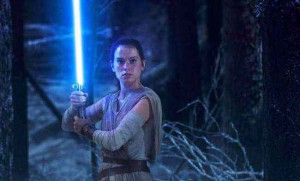
Seeing Obi-Wan hand Luke Anakin’s lightsaber is also one of those moments that gets more loaded with resonance and meaning every few years.
Seriously, it’s the scene or moment that keeps growing. After ROTS, it became so much more resonant, because we had the memory burnt into our minds of Obi-Wan reaching down to pick that saber up as Anakin is being engulfed in flames in front of him (and we knew then it was also the saber Anakin used to murder younglings, slay Separatist leaders, and fight Obi-Wan). Now, post TFA, we have the future history of that lightsaber coming to mind – not just how Luke will fight Vader with it and lose it, but also how it ends up with Rey, who’ll use it to fight Luke’s nephew and will eventually find its way back to Luke again.
That weapon’s had a hell of a life story.
I think what all of this reaffirms for me is that A New Hope is significantly strengthened by subsequent films.
In general, it’s difficult to watch any Star Wars film anymore without referencing other Star Wars films.
This is the way Lucas designed all these films to work in the long run; you watch ANH with ROTS (and now Rogue One) ringing in your ears. This occurs all throughout the film; even the Lars homestead scenes, for example, get me thinking of the equivalent scenes in Attack of the Clones (and the murder of Shmi Skywalker); or to see Luke attacked by Tusken Raiders and not think of how his grandmother died.
That’s obviously a key part of the beauty of Star Wars now that Lucas got to play out his full vision for the broader saga – it all works as a rich tapestry, with various threads connecting all the films together on different levels (and that’s just on a fairly surface reading, not even anything as complicated as Mike Klimo ‘Ring Theory’ territory).
Having said that, it’s also become difficult to watch A New Hope without a bunch of other things coming to mind too: such as, for example, the Family Guy parodies of the OT films or the much better Droid Tales reinterpretations. Which isn’t always helpful – I keep thinking of the Family Guy couch scene whenever I watch Han and co trying to escape the Death Star. And of the alternate explanation for how the Lars homestead caught fire (if you haven’t seen the Robot Chicken Star Wars shows, you really should).
Any other notes? This older, original version of Lars and Beru actually do bear a good resemblance the younger versions cast in Episodes II and III. You really can see it, which is great.
Also, for the record, when I did this particular rewatch of A New Hope, I did the original (non Special Edition) version on 80s VHS.
Which is neither better nor worse than doing the updated versions; though it does allow me to avoid the Jabba/Boba add-on that I’ve always found awkward and ineffective. Although watching the revised/updated versions (especially on DVD) are probably better, there are times I find myself wanting to watch the old-school VHS, even with its less crisp qualities. Perhaps it is simple nostalgia.
All in all, viewing number 51 (approx) of A New Hope is still an interesting, ever-evolving experience.
What’s fascinating, as mentioned, is how much this film has changed since I was a kid, in terms of how much the context and resonance has evolved on account of the other movies, including the prequels and now the current offerings.
I in fact expect it to continue to evolve that way, so that viewing this same film a few years from now will be different yet again, on account of some new release that impacts this narrative even further.
That’s a fascinating dynamic, really; and I don’t think there’s any film in cinema history that continuously has so much added to it over such a long time.
Here’s to 40 years of Star Wars. Pretty sure I’ll still be rewatching it 40 years from now too.

